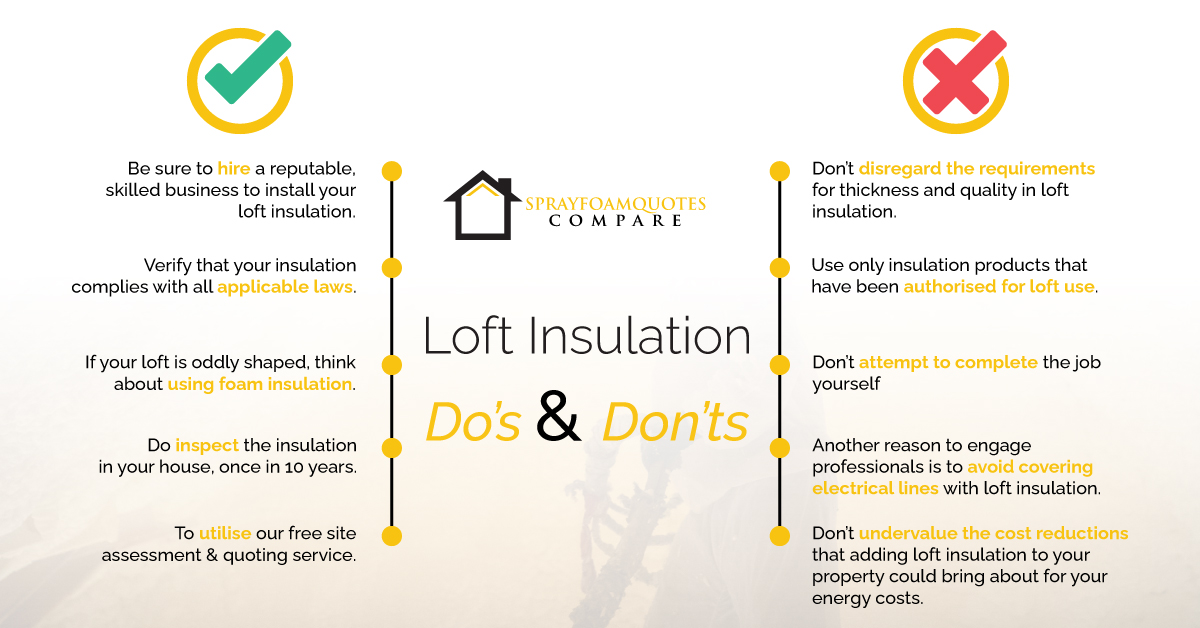Loft insulation keeps the air in your home warmer for an extended period by trapping heat beneath the loft space. Additionally, it aids in preventing cold air from penetrating your home from the loft. Loft insulation assists you to save thousands of pounds a year on energy bills by preventing heat loss.
Loft Insulation Do’s and Don’ts
Here is your complete list of loft insulation dos and don’ts:
Dos for Loft Insulation
There are several loft insulation dos and don’ts to take into account while putting in or upgrading loft insulation.
1. Be sure to hire a reputable, skilled business to install your loft insulation. If you are taking shortcuts to find the cheapest quotes then you can become a victim of long-time charging.
2. Verify that your insulation complies with all applicable laws. The suggested minimum depth for glass wool is 270 mm. Before beginning an installation, take the time to learn as much as you can about insulation to ensure that your home is as energy-efficient as possible. Here are some things to think about.
3. If your loft is oddly shaped, think about using foam insulation.
This may be blasted into crevices and cracks with the use of a pump and compressed air, allowing you to continue to benefit from loft insulation even in difficult places.
4. Do inspect the insulation in your house, especially if it has been there longer than ten years. It’s likely that your home might use an extra layer of insulation, and it doesn’t matter how long the loft’s current insulation has been there; it can always be removed.
5. To utilise our free site assessment and quoting service, will help you understand how you can save expenses on energy bills by installing loft insulation.
Don’ts for Loft Insulation
The loft insulation dos and don’ts are particularly important to keep in mind because they mostly deal with saving money and keeping you safe.
Following are some of the most significant loft insulation don’ts:
1. Don’t disregard the requirements for thickness and quality in loft insulation. Ignoring them could result in wasting pounds on insulation that doesn’t truly keep heat in your home.
2. Use only insulation products that have been authorised for loft use. The appropriate materials have been selected for their longevity, moisture performance, durability and many other factors.
3. Don’t attempt to complete the job yourself; a qualified professional contractor must install this professional product. While applying spray foam insulation can also be risky if you don’t know what you’re doing, removing old insulation could expose you to potentially hazardous asbestos.
4. Another reason to engage professionals is to avoid covering electrical lines with loft insulation. This could result in overheating, which might start a house fire.
5. Don’t undervalue the cost reductions that adding loft insulation to your property could bring about for your energy costs. When you consider that the roof can allow up to 25% of your home’s heat to escape.
In fact, with spray foam, users will not only exceed regulatory requirements for a minimum insulation thickness of 270mm while saving money on energy costs; you will also benefit from a warmer, cosier home in the winter and a cooler home in the summer.
Reasons why Spray Foam Insulation Is Effective?
So how does insulation made of spray foam work? Using a hose and pressurised air, it is sprayed over the application site, growing up to 100 times its size upon impact, and hardening virtually immediately.
This prevents the loss of heat through your roof while still enabling your building to breathe, covering every nook and corner of even the most strangely shaped loft rooms with a blanket of insulation.
One of the most efficient and environmentally responsible ways to insulate your home is with spray foam insulation, and it is also a very affordable and economical insulation choice preferred by all.
Conclusion
Assessing to see if your property is properly insulated is a fantastic place to start if you want to reduce your heating costs with Home base loft insulation. Your home will benefit greatly from having adequate loft insulation because less heat will be lost through the roof.
As a result, you will be able to reduce your heating costs by up to 15%, as well as your carbon footprint and your family’s ability to stay warm during the cooler months. Loft insulation can also improve your home’s EPC rating, which will increase the value of your home and appeal to more purchasers.


